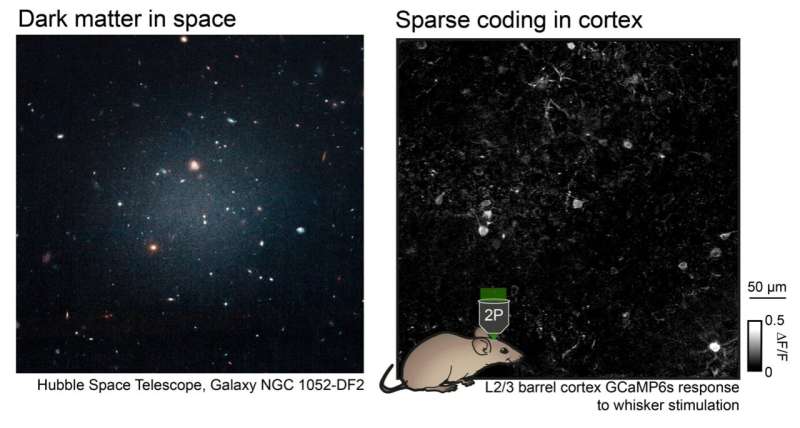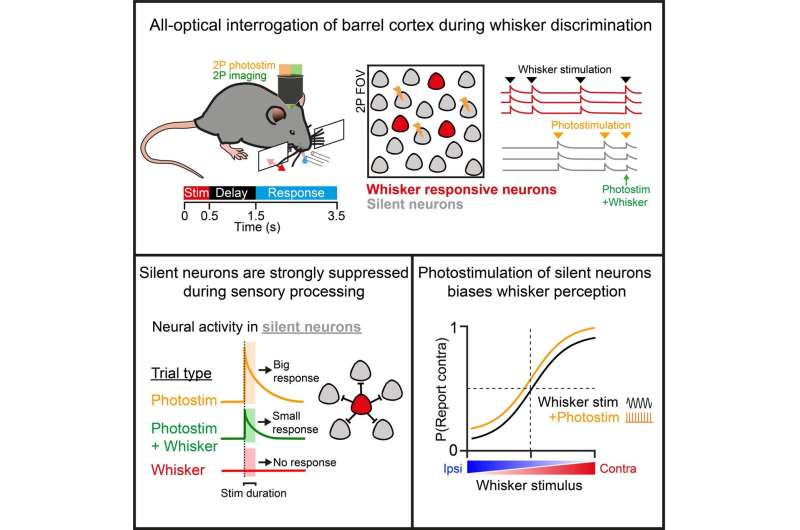August 15, 2024 feature
This article has been reviewed according to Science X's editorial process and policies. Editors have highlighted the following attributes while ensuring the content's credibility:
fact-checked
peer-reviewed publication
trusted source
proofread
'Silent' neurons in the sensory cortex can be recruited to enhance sensory processing

The somatosensory cortex is a region of the mammalian brain known to play a crucial role in the processing of sensory information, including tactile sensations, temperature and pain. While this brain region has been the focus of numerous neuroscience studies, its unique contributions to perception-related decision-making remain poorly understood.
Researchers at University College London (UCL) recently carried out an experiment exploring the links between activity in the mouse sensory cortex and perceptual decision-making. Their findings, published in Neuron, hint at the existence of neurons that typically remain silent during sensory processing and yet can be recruited to enhance perception in mice.
"The study was inspired by two major advances in the field," Oliver M. Gauld, co-author of the paper, told Medical Xpress. "The first is the development of optical tools to simultaneously record and optogenetically stimulate the same population of cortical neurons (referred to as cellular resolution 'all-optical' interrogation). The second is the development of approaches for studying sensorimotor decision-making in head-fixed mice."
As part of their recent study, Gauld and his colleagues combined recently developed optical tools with sensorimotor tasks to investigate decision-making in head-fixed mice. Their goal was to use these different approaches to identify neurons and cortical activity patterns that relate to the generation of sensory perceptions in mice.
To carry out their study, the researchers designed a simple but powerful perceptual decision-making task. During this task, mice need to determine whether a sensory stimulus delivered to their whiskers was stronger on the left or right side of their snout.
"Mice reported their decision by licking left or right at two waterspouts and were rewarded with sugar water for correct responses," Gauld said. "We then used an optical technique called two-photon calcium imaging to record neural activity signals from the whisker-responsive area of somatosensory cortex (also called 'barrel' cortex).
"This allowed us to characterize how task performance changed brain activity—enabling us to identify which neurons responded to presentation of the sensory stimulus."

When they analyzed the two-photon calcium imaging recordings they collected, Gauld and his colleagues found that the activity of a small portion (i.e., approximately 15%) of neurons in the animals' cortex increased after the mice's whiskers were stimulated. This finding is aligned with previous research observations, which demonstrated the "sparse" cortical coding of sensory inputs in mice.
"The key part of our study was that we then used a sophisticated system for two-photon optogenetic manipulation to stimulate different groups of neurons (essentially forcing these neurons to become active) and assessed whether this changed the animal's perceptual choices," Gauld explained.
"Specifically, we used a spatial light modulator (SLM) to deliver holographic patterns of light into the tissue. This means that the experimenter has very good control over which neurons are optogenetically stimulated—which is essential for investigating how sparse sensory patterns of activity causally drive behavior."
Using a combination of two-photon calcium imaging and SLM-targeted optogenetics, the researchers were able to characterize and manipulate highly sparse patterns of neural activity in the mice's brains while the animals completed the decision-making task.
Interestingly, the researchers found that the optogenetic stimulation of "silent" neurons in the cortex strongly influenced the behavior of the mice examined as part of their study.
"Silent neurons refer to neurons that do not show task-related activity—remaining inactive despite presentation of sensory stimuli and execution of behavioral decisions and motor actions," Gauld said. "Experimental evidence suggests that silent neurons make up most neurons in the superficial sensory cortex, as only very few neurons fire action potentials during sensory stimulation.
"This is a hall-mark characteristic of the sparse coding hypothesis. While the functional role of these silent neurons has remained elusive for many years, our study suggests that these neurons can play an important role in sensory processing, but only if they are un-silenced first."
Overall, the findings gathered by this team of researchers suggest that "silent" neurons in the sensory cortex are maintained quiet by a very strong network inhibition while mice are completing a decision-making task. However, the activation of some of these neurons, such as those realized using SLM-targeted optogenetic manipulation tools, can significantly enhance the animals' sensory perception.
"Our findings have important implications for understanding how cortical circuits implement sparse cortical coding and sensorimotor plasticity, which could be important for learning," Gauld added.
"One interesting avenue for future research would be to investigate the causal role of silent neurons in other cortical areas, or in other behavioral and cognitive processes. This would provide a more comprehensive account of the role of silent neurons in the brain."
More information: Oliver M. Gauld et al, A latent pool of neurons silenced by sensory-evoked inhibition can be recruited to enhance perception, Neuron (2024). DOI: 10.1016/j.neuron.2024.04.015
© 2024 Science X Network





















